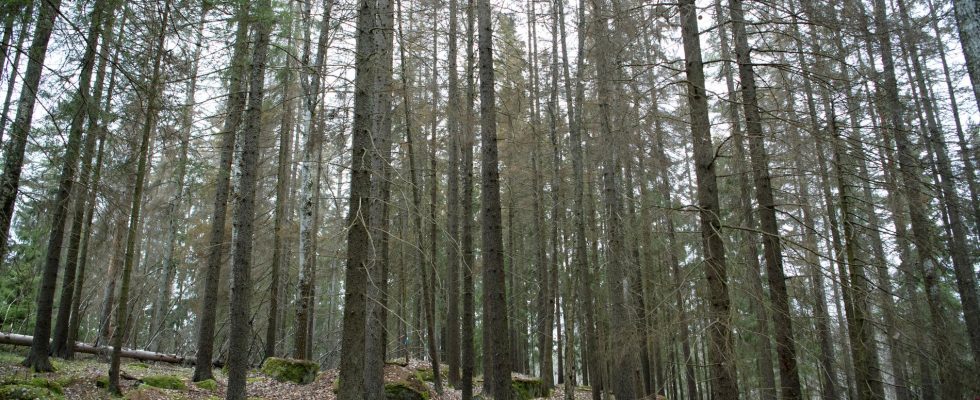1 / 4Photo: Jessica Gow/TT
Four millimeters long, it sets the hook for climate goals and causes billions of dollars worth of damage. Now scientists are warning of a disaster scenario with the spruce bark borers if the summer continues on the beaten track.
It started in the summer of 2018. At the same time as the shops were emptied of fans and forests were burning, a small beetle was given exceptionally good conditions to reproduce – and kill firs.
The outbreak of spruce bark beetles that began then is still ongoing. If the drought continues, it could reach new levels this summer.
– If it continues like this, it risks becoming a disaster scenario, says Martin Schroeder, professor of forest entomology at the Swedish University of Agricultural Sciences (SLU).
He believes that the outbreak that has been going on since 2018 is unprecedented.
– We have had six outbreaks of spruce bark beetle in Sweden since the beginning of the 1960s, and what is going on now accounts for 70 percent of the total volume of spruces killed. It is exceptional.
“Extensive damages regardless”
According to SMHI, it is too early to predict whether the heat and drought will last. According to the researchers, the weather is the most important factor in how large the attacks will be.
– But since we start with a high population level, we can count on extensive damage regardless of the weather. But exactly how big the damage will be remains to be seen, says Mats Jonsell, researcher in forest entomology at SLU.
An attack makes it more difficult to reach the climate goals. The dead spruces stop absorbing carbon dioxide from the atmosphere, and when they are felled and burned, or decay naturally, the carbon stored in the wood is released.
At the same time, most evidence suggests that damage by spruce bark beetles will increase in the wake of climate change as summers become hotter and drier. Even milder winters with less frost on the ground increase the risk of storm-felled trees where the bark beetle can reproduce.
More litters of siblings
Why heat and drought make the little creep so successful, scientists aren’t sure. Every fall since 2018, Martin Schroeder goes out into the forest to carve bark samples from dead spruce trees. There he looks for tracks that reveal how many spruce bark beetles have broken loose on each tree: males that first gnawed their way in and females that then drilled passages for the eggs.
The research results indicate that fewer spruce bark beetles are required to attack a drought-weakened spruce. Thus, they manage to kill more firs.
– They also manage to lay more litters per summer when it’s hot and the drought makes it easier for them to find material to reproduce in, says Schroeder.
Since the start of the outbreak in 2018, approximately 32 million cubic meters of spruce have been killed by the insect, to a value of SEK 14 billion according to the Swedish Forestry Agency’s calculations.
At the same time, developments in modern forestry have paved the way for the progress of the bark borer. The clearing filled with uniform fir plantings favors the little beetle when the firs have grown up, according to Mats Jonsell.
– They have planted so much spruce because it produces good boards and paper pulp. But now people are starting to have more doubts about whether it is so wise, he says.
A sandwich board
Amidst the misery, the spruce bark borer also has some positive effects.
The dead wood – a scarce commodity in the modern forest – becomes a smorgasbord for hundreds of animal and plant species, several of which are red-listed. Although infested trees must be removed to reduce the risk of spread, it can be difficult to remove everything.
A large part of biological diversity benefits in this way from the eruption, which has been called “a natural disaster in slow motion”.
– Many species have evolved characteristics that allow them to take advantage of disasters such as forest fires or insect attacks, for example beetles that benefit from sun-warmed dead trees, says Jonsell.
FACT Spruce bark borer
There are approximately 90 species of bark beetles in Sweden, of which almost 30 can live on spruce. The one that does a lot of damage is the eight-toothed bark borer, which is about four millimeters long.
The teeth are actually spikes, four on each side of the drill.
Wind-fallen firs are the insect’s easiest “prey”. Even living trees can be attacked if they are dry or otherwise weakened. The borer can smell spruces that are stressed.
The fir’s defense in the event of an attack is to try to “drown” the intruders in resin.
The most important measures against the bark borer are not to plant spruce on unsuitable, too dry ground, and to quickly drive the windfall or other infested trees out of the forest.
Source: The Swedish Forest Agency, SLU.
Read more
